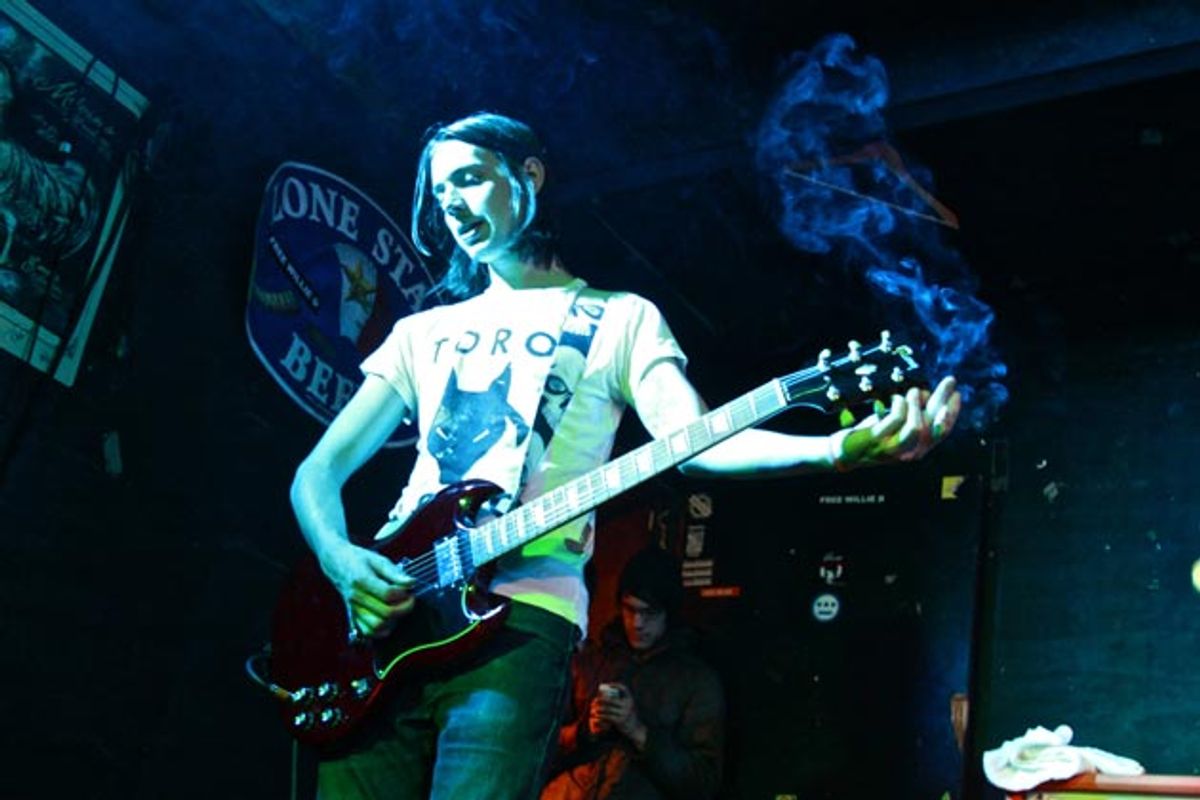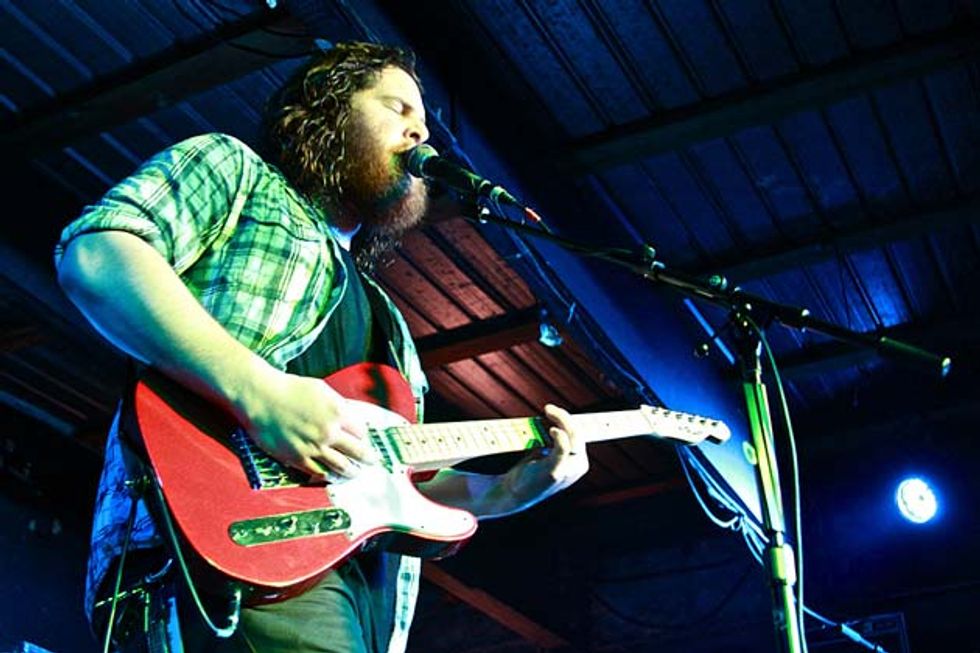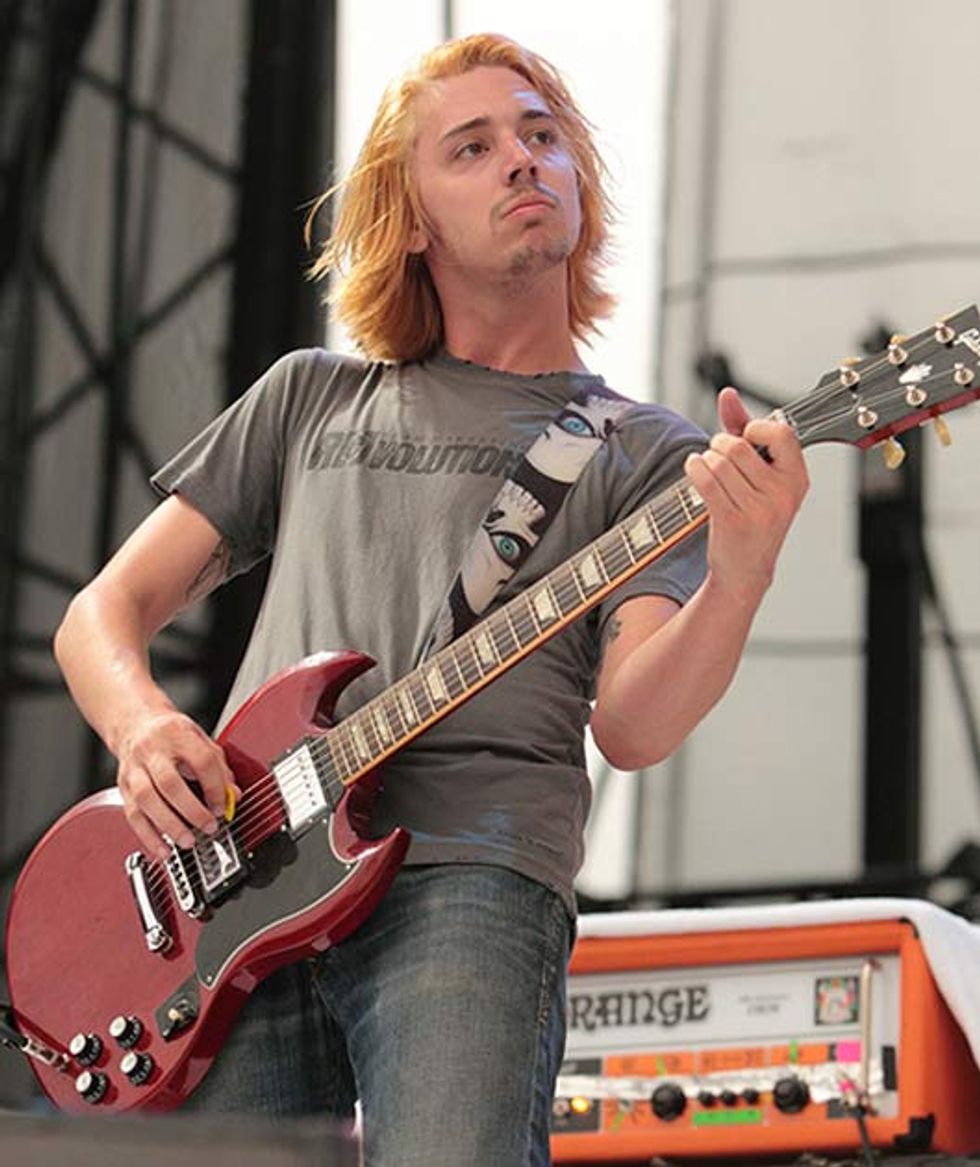
Andy Hull and Robert McDowell deliver a dual-guitar coup de main on Cope—the Atlanta indie-rockers’ heaviest record to date.
Electric bees swarming in harmony. Tectonic plates slowly grinding over a fault line of pickups. A surging tsunami ridden by Homer’s Sirens as they call Odysseus and his men toward a volatile fate.
Those may seem like abstractions, but the supremely overdriven sound of the new Manchester Orchestra album, Cope—which frontman Andy Hull describes with a single word, “brutal”—puts gravel in their bellies. But what the album truly sounds like is a creative breakthrough for the uncannily hardworking Atlanta quintet that’s propelled by the dual 6-string thrust of Hull and Robert McDowell, childhood friends and kindred spirits who do for post-atomic-age rock guitar what gospel-raised Southern siblings like the Louvin Brothers did for close harmonies.
To listeners casually familiar with the band through breakthrough tunes like 2006’s “Wolves at Night” or 2011’s “Simple Math,” Cope may seem like a radical departure. After all, those hits were fueled by the post-Cobain mantra of alternating loud and soft dynamics in support of melodic pirouettes that soften the edge of Hull’s lyrics.
“A lot of people who've never seen us live think of us as playing pretty music—which we do, and we enjoy,” notes Hull. “But this album is as relentless as our live shows.”
Although Cope does stand up on its hind legs and beat its chest, its noise also comes from mental static. Few songwriters today have Hull’s psychic pipeline into the minds of his characters. His gift for interior perception makes offerings like “The Mansion,” about a lost, hollow-hearted soul, and “The Ocean,” a roiling tribute to futility, seem nakedly genuine and haunted.
Then there’s the gift for hooks, melodies, and harmonies that’s deep in Hull’s and his bandmates’ collective DNA. Manchester Orchestra seems so instinctually adept at upholding those values that they’re able to build a sing-along vibe into the neurosis of “Indentions,” which starts with a church burning and chews on lines like, “It doesn’t matter to me … I tell myself repeatedly/What a nightmare it seemed to honestly think of anything.”
“We’re at a point as a band where the hooks come out naturally in every song,” Hull explains. “We don’t have to think about it. Everybody was on the same page every step of the way in making this album, and as we put together the songs in the studio things just fell into place exactly how they needed to.”
Hull’s voice also lends a buoyance to the band dynamic. He channels his airy tenor into rising and falling melodies—a trick he learned from one of his ’80s and ’90s post-punk heroes, Morrissey, whose hometown of Manchester, England, inspired the group’s name.
Andy Hull's Gear
Guitars
T-style with a Seymour Duncan Little ’59 bridge pickup
Amps
Fender Hot Rod DeVille
Fender 4x10 extension cabinet
Effects
Boss BD-2 Blues Driver
Electro-Harmonix Holy Grail Reverbs
Fulltone OCD
Strings and Picks
Ernie Ball 2220 Power Slinky sets (.011–.048)
Jim Dunlop .73 mm and .60 mm Tortex picks
Jesus, Dinosaurs, and Pumpkins
Cope’s evolutionary leap was accomplished in part by looking back to those same decades, too—a time when rock guitar’s territory was wide enough to encompass the subterranean growl of the Jesus and Mary Chain, the 6-string howl of Dinosaur Jr.’s J Mascis and Smashing Pumpkins’ Billy Corgan, and the frayed harmonic declamations of Sonic Youth and Glenn Branca. Hull and crew even drafted John Agnello—an expert at wrangling the untamable guitars of some of the aforementioned acts, as well as the Screaming Trees, the Breeders, and Kurt Vile—to mix Cope. “John kept saying, ‘This is so My Bloody Valentine—on steroids,’” Hull says, laughing.
But looking ahead to a blank canvas also lit the fire for Cope. “We had come home after touring behind Simple Math, and found ourselves without a record label, wondering what we were going to do next,” Hull recalls. “We had a band meeting about it, and all five of us said, ‘Let’s make something super heavy, something where the guitars are as powerful as the drums and it never slows down—a no-holds-barred rock record.’
“There are only a few super-heavy rock bands with real songwriting out there these days,” he continues. “We wanted to get away from all the trendy electronica and sampling stuff too many bands are doing, and make a great guitar record that doesn’t sound like anything else—like when Led Zeppelin and Hendrix changed music in the ’60s.”
While invoking those two names is bound to raise some hackles among some players, the band’s core mission seems to have been accomplished: Cope is replete with 6-strings that rise and ebb but never lose their power as the songs unfurl. The trick was layering as many as 10 guitar tracks on each tune, all slightly varied in tone and execution so that, even when Hull and McDowell played the same chords, their varied picking, amp choices, and instruments created small differences that make the combined tracks pulse like a hive.
Guitarist and singer Andy Hull belting out while playing his trustee T-style axe. Photo by Krista De La Rosa.
Everyone Gets a Vote
The monolithic guitars on Manchester’s latest won’t sound foreign to die-hard fans who’ve heard the band’s sound grow increasingly heavy onstage during the past decade. “Right from the start we needed to rock hard at concerts,” Hull says. “We were opening shows for other bands, and quickly learned that if we weren’t loud and in people’s faces, they’d totally ignore us. Cope is what our music sounds like onstage. The amps are roaring up there, and this is the first time we’ve been able to capture that sound in the studio.”
The group once again recruited friend and collaborator Dan Hannon to co-produce. They also built their own studio in the Atlanta house they once shared. McDowell and drummer Tim Very both have construction experience and oversaw the project, which delayed the album’s start, but saved money on the studio time Cope’s meticulous creation required.
“When we were making the album, we’d have breakfast together every day and then go into the studio to create a song,” Hull recounts. “We’d start by jamming on a riff or another idea, and then when it was starting to take shape I’d go off in a corner and write some lyrics about whatever was on my brain that day, and then we’d come back to finish the form. Then we’d play it three or four times and comp together a version, and I’d stay late putting on the vocals.”
Sonic Stacking
The secret to Cope’s pummeling tour de force o lies in the strategy guitarists Robert McDowell and Andy Hull employed when layering their instruments. “At certain points you want to go down different rabbit holes,” McDowell says. “Our goal has been to make our records sound bigger and bigger than a five-piece band typically does, and this time we really nailed it.”
Only two guitars were deployed in the sessions: McDowell’s Fender 1972 Telecaster Deluxe, which he swaps out with an SG Standard onstage, and the parts-built T-style solidbody that Hull uses for everything.
They fired up a variety of amps, including Hull’s Fender Hot Rod DeVille stage rig and McDowell’s Vox AC30, which was also routed to a Marshall 4x12. “I wanted to be louder onstage, so I started powering the Marshall cab with my Vox to get six speakers moving air,” McDowell explains. “Although I did that just to get more volume, I noticed that the Marshall was also making my sound darker. Now I’m totally smitten with it!
“Since Andy and I have very different tones, that was a starting point for layering,” he continues. “We began recording the guitars for each song with both of us in the same room, playing the same part together at the same time, but with each of us using two different amps. In order for the layering to work, we needed to marry the guitars into one great tone as the foundation.”
Then came a second pass, where they exchanged and mixed amp, head, and cabinet combinations. They brought in a Fender Super-Sonic cab, as well as a Fulltone OCD pedal for the sessions. That gave every song as many as eight foundational guitar tracks to work with at mixing. Next, additional leads and overdriven sounds were added, sometimes going direct, occasionally with Hull’s Boss BD-2 Blues Driver pedal slamming the recording console’s preamps.
Hull explains that duplicating tracks of the same chord progressions by recording separate performances, rather than simply copying them via Pro Tools or using a multitude of isolated amps simultaneously, gave the album a more live and detailed sound. “All the slight differences in the picking, attack, and tone we used every time we played a track really comes through and makes the guitars sound bigger,” he says.
A few carefully curated stompboxes were also used. Two Electro-Harmonix Holy Grail Reverb pedals were used at once to get the cathedral-like sounds that ramp up to the crescendo of “The Mansion,” and that song’s secret weapon was a Walrus Audio Janus—a tremolo/fuzz that McDowell describes as “completely blown-out and insane sounding. It entirely changes your tone. There are two joysticks to control the fuzz and tremolo separately, and I was down on the floor playing with those as I recorded.”
That process yielded 28 songs before the band felt they had the anatomy of Cope. “Everybody had to be in agreement that every song was a home run,” says Hull. “Doubles and triples are sometimes really good for an album, but our goal was that if everybody didn’t feel a song was totally awesome, it wasn’t going on the record.”
Hull tried to nix the track “Top Notch,” which pits Very’s offbeat drums against cascading waves of burly guitar and a desperate vocal performance. But McDowell, Very, keyboardist/percussionist Chris Freeman, and new bassist Andy Prince argued for its inclusion. The tune ultimately became the first single, released in January.
Photo by Owen Sweeney—Frank White Photo Agency.
The Best 16 Seconds
Manchester Orchestra’s democratic spirit rests on the axis of Hull and McDowell’s friendship. They met in school, as music-obsessed teenagers. Both were already playing guitar. McDowell was initially inspired by Christian rock and AC/DC, and Hull, several years older, was listening to everything from Morrissey’s the Smiths to roots-rockers Wilco, visceral storytellers Built to Spill, and Delta bluesman Son House. They started recording songs in McDowell’s primitive basement studio, and when Hull decided to start Manchester Orchestra he invited McDowell to join. “I was 14, and my mom said, ‘No,’” McDowell recounts. “Two or three years later, I joined the band and we’ve been doing it since.”
With their music and personal lives intertwined—Hull is also McDowell’s brother-in-law—it’s no surprise that the guitarists play together as if they share lungs. That cohesiveness and their work ethic have driven them to relentlessly tour and record four albums and eight EPs over the last decade—not to mention each band member’s solo projects.
“If Andy or I come up with the coolest part, that’s what gets played. It doesn’t matter whose stamp gets put there,” McDowell relates. “The best thing to do is to always put your pride aside, and to put what’s best for the song and the band first.”
Nonetheless, Hull says his pal McDowell is the most likely to conjure a daring solo off the cuff, like the bright, bristling melody that brings the ominous “See It Again” to its crescendo. “He was playing a scratch track as we were demoing the song and got bored with the part he was playing, so he just ripped out this solo,” Hull remembers. “It was through a cheap transistor amp, but it sounded so great that we kept it.”
Robert McDowell’s Gear
Guitars
Fender ’72 Telecaster Deluxe
Gibson SG Standard with Burstbucker pickups
Amps
Vox AC30 driving a Marshall 4x12 cab
Orange OR50 driving a Marshall 4x12
Effects
Walrus Audio Iron Horse, Jupiter, and Janus
Two Electro-Harmonix Holy Grail Reverbs
Strings and Picks
Ernie Ball 2220 Power Slinky sets (.011–.048)
Jim Dunlop .73 mm and .60 mm Tortex picks
And then there’s the title track, which brings the album to its final reckoning and serves as its emotional mission statement. “The word ‘cope’ means getting by, letting go, being able to find a way to deal with the bad things in life,” Hull states. “We’ve been in this band since we were teenagers, so we’ve grown up playing this music. You can cope in a positive way or a negative way when bad things happen. And that inspired me a lot when I was writing lyrics.” The song is a 10-layer cake of growling guitars that perfectly match the lyrics, bemoaning the sometimes-crushing weight of the human experience. But while cheerful melodies and catchy riffs counterbalance most of Manchester’s pessimistic outings, here we’re left to founder, to listen as the album closes with dying gasps of feedback.
Despite the bleakness of that title track, Hull and McDowell are both elated with the album and are proud to have made what they consider to be Manchester Orchestra’s finest recording. “Every note, every lyric—even the intros … if it’s a 16-second intro, it’s absolutely the best 16-second intro possible,” Hull asserts. “ We kept pushing ourselves in every way to make a great rock record, and this album speaks for itself.”


